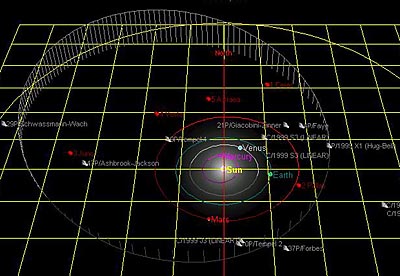
Comet Hug-Bell Discovery!

Comet Hug-Bell Discovery!

Click for larger image
The world cheers as local Amateur Astronomers and general neat guys turn up the faintest comet ever discovered by an amateur.
Comet Hug-Bell was discovered Thursday night from Farpoint Observatory in Eskridge, Kansas by Gary Hug and Graham Bell while they were doing routine asteroid search work using their automated telescope and CCD camera. Hug, 49 of Topeka and Bell, 64 of Maple Hill, Kan., are believed to be the first amateurs to discover a comet. "I've been looking for comets on and off for about 25 years," Hug says. "It was a terrific thrill." The International Astronomical Union, made the announcement over the weekend after staff members were able to make the confirmation.
Hug and Bell have calculated that it should be visible to Earth every seven years; as it makes it's orbit in around the Sun. "They did a great piece of work on it," said Brian Marsden of the Minor Planet Center, Harvard/Smithsonian Center for Astrophysics in Cambridge, Mass. "It's really quite an accomplishment".
Members of the Northeast Kansas Amateur Astronomers League, Hug and Bell (affectionately known in the area as Frick & Frack) went to their club's observatory about 9 p.m. Thursday to perform observations in search for asteroids. The equipment used for the discovery include a 12" Schmidt-Cass and CCD imaging equipment. They first noticed the fuzzy spot at about 1 am on Friday. After increasing the exposure to 10 minutes, they noticed it had a fuzzy head and short cometary tail. They increased the exposure time to 20 long minutes, they were able to better confirm that the object showed a discernible tail at pa ~285.
While the normal approach is to use two telescopes for discovery and follow up work, that process was altered Friday morning, as one scope was shut down for Graham to perform the astrometry. Gary continued to image the new object and as soon as 5 good data points were derived, the submission was sent to the Minor Planet Center. A request was also sent to Catalina for comrade, Tim Spahr to image the object from their larger equipment. Unfortunately, Catalina was clouded out, but was fortunate enough to have imaged this sliver of sky earlier. Mr. Spahr then compared the current image with an earlier November 11, 1999 image which also contained that object.
Meanwhile, other experts, Carl Hergenrother and Lenka Sarounova both observed the object and concurred that it was, indeed a comet. Marsden then connected the object with sightings back to October 10 and December 7.
With such a significant work of astrometry and history, this object was declared a comet
(P/1999 X1 Hug-Bell) in less than 48 hours!
[Educational Features] [Favorite Links] [Recommended Vendors] [Shopping Page] [Astronomy Photos]
Site designed, built, maintained and hosted by ICSTARS
All images, graphics, photos and text © 1999 Vic & Jennifer Winter, ICSTARS Astronomy